- Blog
- Generative AI
- eCommerce
- 11 min read
eCommerce & Retail Automation Made Effortless Now!
Published
10 June 2025Updated
2 September 2025

CORE INSIGHTS BOX
- Smart entrepreneurs are choosing eCommerce automation by enabling smarter, faster, and more personalized operations.
- From pricing and content to marketing strategy and support, automation now covers the entire eCommerce funnel.
- Retailers can scale efficiently, reduce errors, and improve customer experience without increasing headcount, by leveraging automation.
- Choose Experro to automate your eCommerce business as we offer an all-in-one platform tailored for modern eCommerce growth.
Can your online business scale without burning out your team?
That’s where eCommerce automation steps in!
From product planning to customer retention, automation in eCommerce and retail has become a competitive necessity.
Traditional tools can’t keep up with today’s dynamic, data-rich environment with high customer expectations. But with AI-driven eCommerce automation work, businesses can streamline operations, boost conversion, and stay competitive, all with less manual work.
In this blog, we’ll dive into how automation for eCommerce and retail can push you towards your next revenue goals.
What Are eCommerce & Retail Automation?
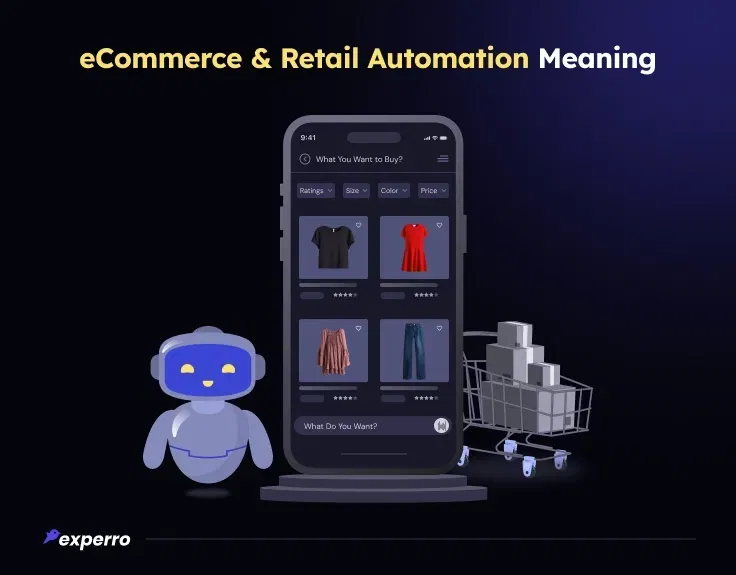
Definitions:
- eCommerce automation uses smart tools to handle repetitive online store tasks, from inventory updates to customer emails, freeing up 20+ hours weekly and eliminating costly human errors.
- Retail automation deploys technology to streamline in-store operations like inventory tracking, checkout, and customer service, creating faster shopping experiences that boost customer satisfaction by 45% while reducing labor costs.
Both include automating processes like inventory level updates, email marketing campaigns, order fulfillment, and even eCommerce customer service automation.
eCommerce automation with gen AI ensures that these tasks are executed reliably and efficiently without constant human intervention.
From eCommerce shipping automation to eCommerce accounting automation, the goal is to save time, reduce errors, and free up your team for strategic work.
With modern eCommerce automation tools, you can create workflows that trigger actions based on predictive customer analytics for customer queries, order status, or inventory management changes, turning manual tasks into smart, automatic flows.
Why Can’t Legacy Automation Keep Up?
Traditional automation in eCommerce was rule-based and limited in scope. These legacy systems struggle to match the speed, scale, and intelligence needed today.

Key shortcomings include:
- Lack of adaptability to changing trends or customer preferences.
- Manual rule-setting which is time-consuming and error-prone.
- Siloed data hence no unified view of real-time insights.
- Scalability issues causing problems for growing or multi-channel operations.
In contrast, AI automation for eCommerce adapts dynamically, learns from customer behavior, and scales effortlessly. The global retail AI marketing, valued at $4.84 billion in 2021, is projected to surge to $31.18 billion by 2028.
See how entrepreneurs are minting money with automation!
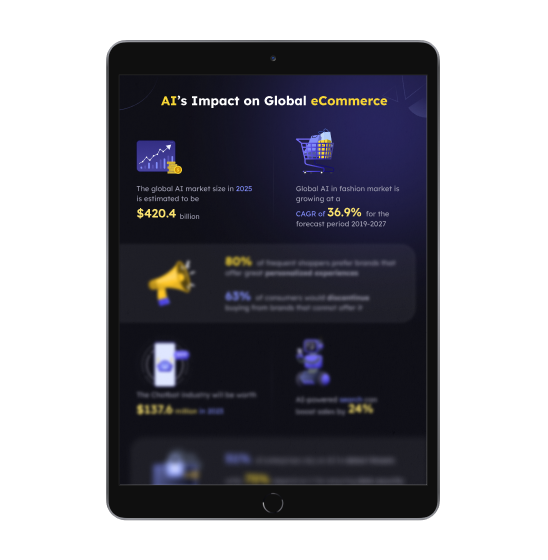
Enter Automated Retail Commerce to Key Function Areas!
Let’s explore how Generative AI in eCommerce automation is reimagining core business functions, going beyond efficiency to deliver precision, speed, and intelligence at every step.
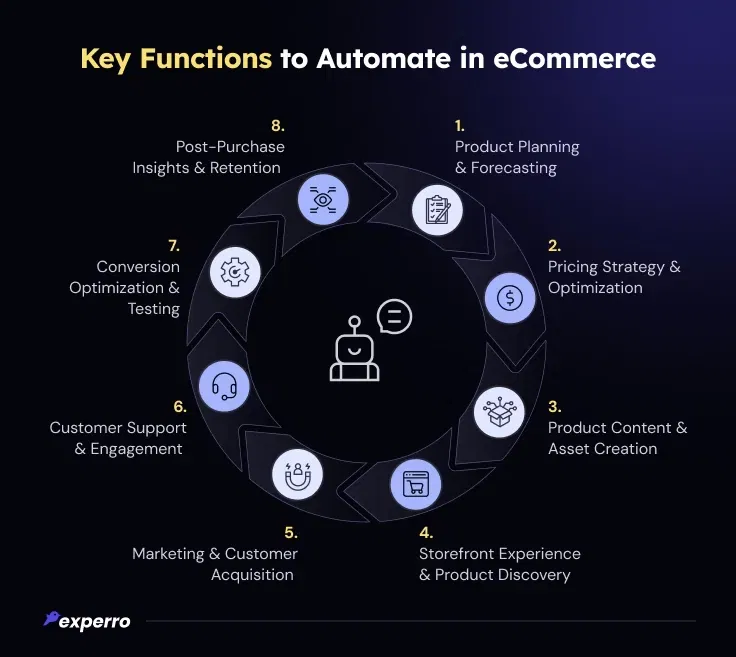
This section will walk you through the silver lining of automating your eCommerce business process:
1. Product Planning & Forecasting
Before adopting AI for forecasting in eCommerce, it relied on static spreadsheets, manual trend analysis, and delayed sales data, leading to overstock or missed opportunities.
After smarter eCommerce business automation, predicting demand patterns across regions, categories, and channels has become easier.
Also product planning becomes a cakewalk as automation enables:
- Analyze sales velocity, weather patterns, regional holidays, and influencer activity to forecast demand.
- Automate inventory alerts and purchase order creation based on eCommerce analytics.
- Trigger eCommerce warehouse automation for just-in-time replenishment.
- Recommend product bundling or deactivation based on sales probability.
- Integrate directly with ERP systems to update stock levels and plan resource allocation.
This level of automation in eCommerce aligns your supply with market signals, reducing stockouts and overstock both.
2. Pricing Strategy & Optimization
Before adopting AI-based automation, pricing decisions were reactive and manual, often based on gut feelings or delayed reports, limiting competitiveness.
With eCommerce pricing automation, AI can dynamically adjust prices across SKUs and marketing channels using real-time competitor, cost, and customer data.
Key capabilities of AI automating your pricing strategy optimization include:
- Detecting price elasticity per product/customer segment.
- Launching automated pricing experiments (A/B or multivariate).
- Creating urgency-based pricing (flash deals, demand surges).
- Coordinating with eCommerce advertising automation to align ad spend and pricing ROI.
- Suggesting pricing tiers based on LTV and acquisition cost.
This results in intelligent automation in retail that’s responsive to both market and behavioral shifts. Valcon’s research shows that AI-driven dynamic pricing can boost revenue by up to 3% and increase profit margins by up to 10%.
3. Product Content & Asset Management
Before implementing AI for content automation, it used to be time-consuming, requiring teams of writers and designers to maintain consistency across SKUs and languages.
eCommerce content automation decreases time-to-market while maintaining SEO and branding standards.
It enables:
- Auto-generation of product titles, descriptions, bullet points, image captions, and meta tags.
- Multi-language support for eCommerce catalog automation.
- eCommerce product taxonomy automation to categorize SKUs based on attributes and trends.
- AI-generated alt-text for improved accessibility and search compliance.
- Integration with DAM systems for automatic image recommendations based on product type.
This ensures your product listings remain fresh, relevant, and discoverable at a scale.
4. Storefront Experience & Product Discovery
Previously, retailers had to rely on rigid, rule-based systems that made storefront personalization slow and inefficient.
Workflow automation in eCommerce for real-time hyper-personalization automates:
- Smart navigation and auto-adjusting homepage banners.
- eCommerce voice automation for conversational search and accessibility.
- Product grid reordering based on user behavior and stock levels.
- Rule-based automation for showing “back-in-stock” or “low inventory” badges.
- Dynamic bundling and offer personalization based on session data.
With eCommerce AI automation, you create a constantly evolving storefront tailored to each user’s journey.
5. Marketing & Customer Acquisition
Before AI-powered marketing automation, running campaigns required long planning cycles, static content, and fragmented targeting across channels.
With eCommerce advertising automation, AI helps craft campaigns that target the right customers at the right time with the right message.
Automation possibilities on the marketing end include:
- Auto-generating ad copy variations for Google, Meta, TikTok, and email.
- Smart budget allocation across ad sets based on real-time ROI.
- Retargeting flows for abandoned carts, browsed items, or seasonal shoppers.
- AI-generated UGC-style creative based on product insights.
- Integration with eCommerce SEO automation tools for landing page optimization.
This automated pipeline transforms marketing into a continuous, adaptive engine.
6. Customer Support & Engagement
Before support automation, support teams were overwhelmed by repetitive queries and lacked personalization, resulting in slower response times and poor CX.
eCommerce customer communication automation ensures:
- Run AI chat support that handles complex product/service issues.
- Trigger automated review requests, loyalty nudges, and order management.
- Escalate high-priority tickets using sentiment analysis.
- Personalize post-purchase emails with AI-drafted content.
- Integrate with customer relationship management systems for a unified customer history view.
This reduces cart abandonment by enhancing the CX and reinforces brand trust through automated retail technology.
7. Conversion Optimization & Testing
There was a time when conversion rate optimization once relied on guesswork, limited testing velocity, and isolated analytics tools.
Turn CRO into a self-improving loop by:
- Automatic A/B and multivariate testing of CTAs, layouts, personalized content, and pricing.
- Real-time adjustments to banners, eCommerce filters, and offers based on user journey insights.
- Predictive funnel analysis to avoid drop-offs and friction.
- Automated insights with heatmaps and scroll-depth tracking.
- Voice-of-customer (VoC) from reviews and chats to influence UX changes.
This is eCommerce task automation that turns every click into insight—and every insight into action.
8. Post-Purchase Insights & Retention
Before automation in retention strategies, efforts were static and delayed, with limited personalization or feedback loops to inform future strategy.
Post-sale is where automated retail commerce shines in customer loyalty and lifecycle automation
AI can:
- Predict churn and send personalized win-back flows.
- Create tailored loyalty reward triggers based on average order value (AOV), frequency, and user-generated content (UGC) participation.
- Suggest personalized upsell/cross-sell products via email or SMS.
- Feed eCommerce accounting automation systems with real-time transactional data.
- Automate feedback loops to inform product improvements or content creation.
It closes the loop with predictive retention powered by AI and automation in retail stores.
Together, this eCommerce automation system leads to a cohesive, intelligent ecosystem, driving efficiency, personalization, and growth at scale.
What Are the Advantages of Bringing Automation in eCommerce & Retail?
Let’s uncover the benefits of eCommerce automation and what else it offers!
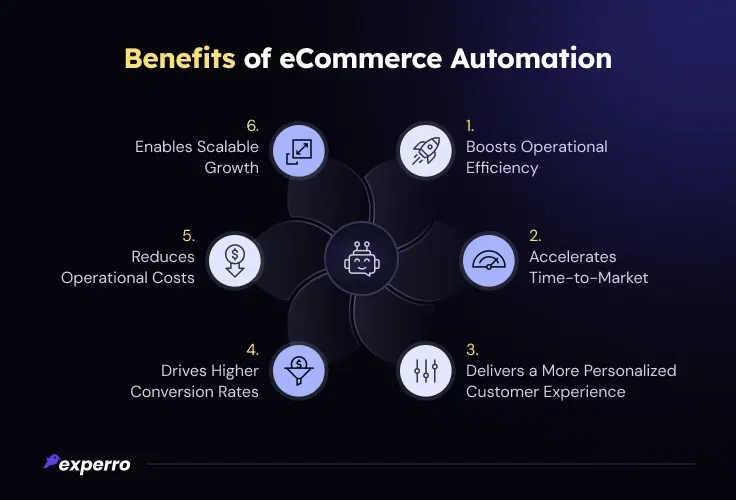
1. Boosts Operational Efficiency
With eCommerce workflow automation, businesses can streamline repetitive tasks, reduce human error, and improve overall process consistency.
AI can automate decision-making and optimize workflows in real-time, making your eCommerce operations leaner and faster.
2. Accelerates Time-to-Market for Campaigns and Products
Content generation, product attributes management, and campaign creation, everything can be sped up with eCommerce AI automation.
Teams no longer need to wait weeks to launch; automation can help you seize trends instantly and act faster than competitors.
3. Delivers a More Personalized and Seamless Customer Experience
AI uses real-time data to power eCommerce personalization, from discovery to delivery.
Generative AI-powered personalization can help ensure shoppers receive relevant content, product suggestions, and support—making them feel seen and understood at every step.
4. Drives Higher Conversion Rates Through Smart Automation
By automating customer journeys, pricing strategies, and content with Generative AI-powered conversion optimization, businesses can create optimized experiences that convert more efficiently.
Intelligent automation in eCommerce platform ensures the right action happens at the right moment, boosting results without constant micromanagement.
5. Reduces Costs by Minimizing Manual Efforts
From eCommerce accounting automation to eCommerce shipping automation, it reduces headcount needs for repetitive tasks. It also minimizes expensive errors, helping your team focus on higher-value activities.
6. Enables Scalable Growth Without Adding Complexity
With the right eCommerce automation platform, businesses can scale effortlessly.
Whether it’s new products, markets, or channels, eCommerce process automation provides a consistent foundation for sustainable, low-friction expansion.
These all cover most of the advantages of eCommerce automation, now let’s jump into the obstacles that businesses face before implementing automation in their eCommerce business.
Let Experro run your e-store (so you don’t have to!)
Key Challenges and Considerations Before Embracing eCommerce Automation
Functional automation isn’t without challenges. Businesses must plan wisely to harness their full potential.
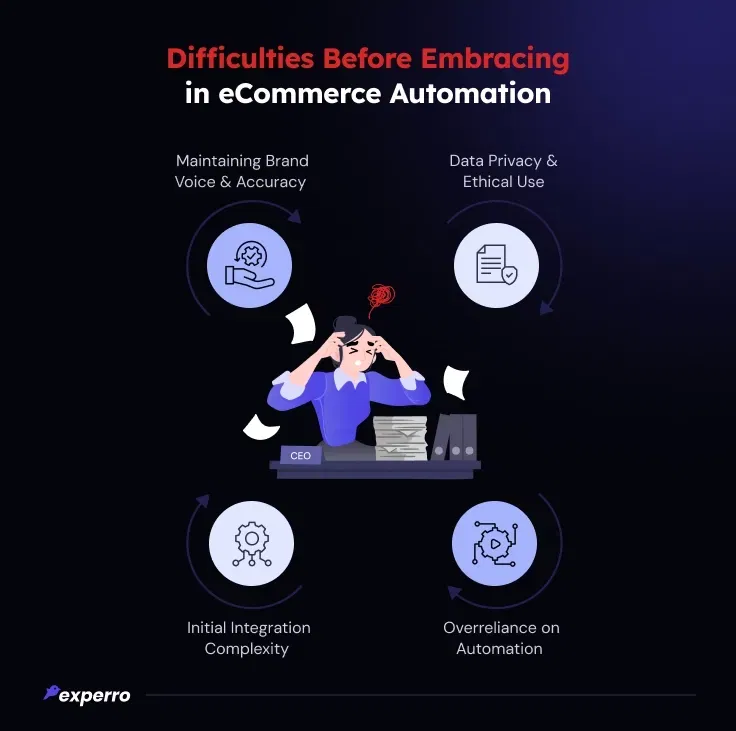
1. Maintaining Brand Voice & Accuracy
Before using AI for content generation, businesses must set clear guidelines to ensure consistent brand voice and tone. Without upfront configuration, AI-generated content may deviate from your messaging standards.
To solve this, Experro offers customizable brand voice settings and built-in review workflows, helping you enforce brand alignment from the start.
2. Ensuring Data Privacy & Ethical Use
Before deployment, brands must assess compliance with privacy regulations like GDPR and CCPA and set ethical parameters to avoid biased or manipulative outcomes.
To address this, Experro is designed with privacy-first architecture and compliance-ready agentic frameworks for secure data use.
3. Defining Boundaries Between Automation and Human Input
Not every eCommerce process should be automated. Before implementing AI, brands must identify where human involvement is still essential, like in customer support or high-stakes communications.
To support this balance, Experro enables hybrid control, allowing teams to define where automation stops and human input takes over across the customer journey.
4. Planning for Integration Complexity
Integrating AI and ML into your tech stack requires upfront planning, internal readiness, and vendor coordination. Poor execution can slow adoption or create operational friction.
To simplify this, Experro provides flexible APIs and hands-on onboarding support to streamline integration from day one.
Tackling these challenges requires the right tech, strategy, and human oversight, exactly what Experro is built to deliver. Let’s explore how it works in the next section.
Understanding the importance of eCommerce experience audit can save your business from costly setbacks and missed opportunities.
How Experro Can Help You Automate eCommerce & Retail Functioning?
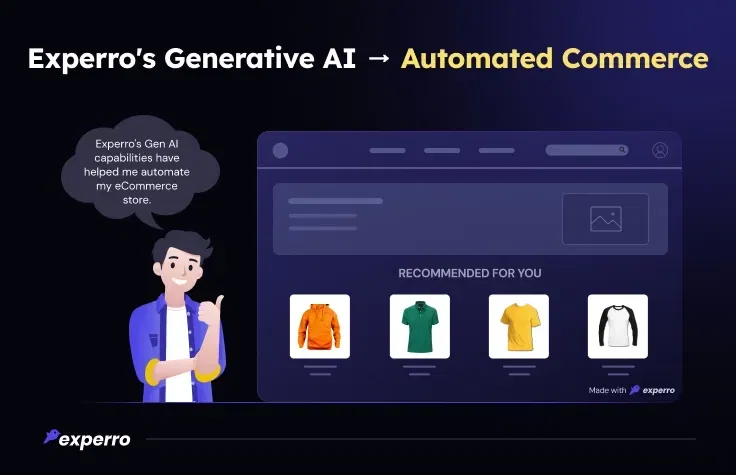
Experro combines generative AI with a robust eCommerce automation platform to streamline and scale your digital operations.
From AI-generated content to predictive testing and eCommerce SEO automation, Experro delivers all the capabilities required to run a fully automated eCommerce business.
It empowers teams with visual workflows, agentic personalization, and multi-channel eCommerce automation—all in one place.
Here’s an eCommerce automation checklist and Experro checks every box!
✅ AI-generated product descriptions and tags
✅ Automated product categorization and taxonomy
✅ Real-time personalization and product recommendations
✅ Predictive testing and conversion optimization
✅ Visual workflow automation for campaigns
✅ Automated email and customer communication flows
✅ Intelligent eCommerce pricing automation
✅ Cross-platform advertising automation
✅ Seamless eCommerce shipping automation integrations
Ready to streamline your automated retail commerce workflow and unlock scalable growth? Schedule a call with our experts to get started.
Final Thoughts
As competition increases and shoppers expect more, eCommerce and retail automation technology are not a nice-to-have; they are a must.
AI brings a new level of automation, helping businesses not just perform tasks faster, but also make smarter decisions. With the right eCommerce automation strategy, you can build faster, more personalized, and scalable experiences.
It’s about working smarter, not harder - cutting manual work while improving results.
And the best part? You don’t need to start from scratch.
Ready to automate your eCommerce functions? Experro is here to help!
FAQs
How does Zara use automation?
Zara uses a smart retail automation process to streamline its supply chain and speed up inventory turnover. This allows them to respond to fashion trends faster than competitors.
The below are the specific automation components Zara leverages in its retail operations:
- Centralized retail warehouse automation
- Real-time stock updates
- Fast product distribution to stores
Which aspect of retail store automation has the biggest impact?
Inventory and supply chain automation often deliver the fastest and most visible results. It enhances delivery speed, reduces out-of-stock situations, and limits excess inventory.
This is especially valuable for eCommerce brands looking to streamline fulfillment without scaling up operations.
How big is the AI retail automation market?
The US retail automation market is projected to surpass $23 billion by 2026, fueled by increasing adoption of AI, robotics, and IoT in retail operations.
As online retailers prioritize efficiency and personalization, spending on automation tools continues to surge.
How to start a fully automated retail store?
Start by identifying repetitive tasks in your operations, then gradually implement the best eCommerce automation tools to handle them.
Platform like Experro help you streamline everything from content to conversions.
Steps to begin retail workflow management:
- Automate email marketing and customer follow-ups
- Use AI to generate product content and recommendations
- Implement retail workflow automation for personalized marketing campaigns
- Add analytics to track performance and scale efficiently
How to automate online selling?
Automate key selling activities using online business automation tools and techniques.
With a platform like Experro, you can centralize workflows and personalize every customer's touchpoint.
Key areas to automate in sales:
- CRM integrations and abandoned cart flows
- AI-based product discovery and recommendations
- eCommerce shipping automation and order automation processing
- Dynamic pricing and content management
Can you fully automate a Shopify store?
Yes, with third-party eCommerce marketing automation platforms, you can automate nearly all core functions in a Shopify store. From content and inventory to customer communication, it’s possible to run a fully automated eCommerce business.
With Experro, you can integrate or re-platform your Shopify store for deeper AI automation, without compromising flexibility or control.
How to automate your eCommerce business?
Automating your eCommerce business involves using software to handle repetitive tasks across operations like:
- Order Processing: Automatically send orders to warehouses or suppliers.
- Inventory Management: Track and update stock levels in real time.
- Customer Support: Use chatbots or AI assistants to respond to common queries.
- Marketing: Set up automated email campaigns, abandoned cart reminders, and personalized product recommendations.
- Accounting & Invoicing: Sync transactions with accounting software to generate invoices and manage taxes.
- Product Information Updates: Use PIM systems to bulk update product descriptions, images, and tags.
- Shipping & Fulfillment: Connect logistics tools to auto-generate shipping labels and tracking numbers.
How does eCommerce automation work?
eCommerce automation works by integrating different tools and systems that communicate via APIs or workflows.
Here's how it functions:
- Trigger-Based Actions: When a condition is met (e.g., a user abandons a cart), an automated response (like a reminder email) is triggered.
- Rule-Based Workflows: You can define rules like "if stock < 5, alert supplier" or "if a VIP customer buys, apply discount."
- Data Synchronization: Real-time syncing between your store, inventory, CRM, and marketing platforms ensures consistency.
- AI & ML: Some systems use AI to optimize recommendations, pricing, or customer segmentation based on behavior and trends.
Pallavi Dadhich
Content Writer @ ExperroPallavi is an ambitious author recognized for her expertise in crafting compelling content across various domains. Beyond her professional pursuits, Pallavi is deeply passionate about continuous learning, often immersing herself in the latest industry trends. When not weaving words, she dedicates her time to mastering graphic design.
What's Inside
- What Are eCommerce & Retail Automation?
- Why Can’t Legacy Automation Keep Up?
- Enter Automated Retail Commerce to Key Function Areas!
- What Are the Advantages of Bringing Automation in eCommerce & Retail?
- Key Challenges and Considerations Before Embracing eCommerce Automation
- How Experro Can Help You Automate eCommerce & Retail Functioning?
- Final Thoughts
Subscribe to Our Newsletters
Get the latest insights delivered straight to your inbox.


